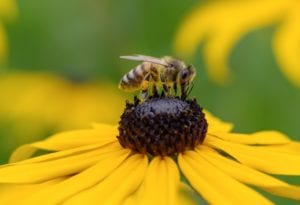Written by Joyce Smith, BS. A bee pollen extract of Schisandra chinensis significantly improved the high-fat diet-induced metabolic syndrome in mice, thereby demonstrating its’ potential to prevent obesity and the development of nonalcoholic fatty liver disease.
 Obesity, an escalating worldwide problem for both children and adults, is associated with a plethora of chronic metabolic diseases including hypertension, type 2 diabetes, cardiovascular disease, nonalcoholic liver disease and even cancers 1-3. Nonalcoholic fatty liver disease (NAFLD), an epidemic in concert with obesity, is characterized by excessive fat deposition in hepatocytes (liver cells) in the absence of significant alcohol consumption 4. Difficult to diagnose in its early stages, it can lead to fibrosis, cirrhosis and malignancy 5, necessitating the urgent need for dietary intervention and prevention.
Obesity, an escalating worldwide problem for both children and adults, is associated with a plethora of chronic metabolic diseases including hypertension, type 2 diabetes, cardiovascular disease, nonalcoholic liver disease and even cancers 1-3. Nonalcoholic fatty liver disease (NAFLD), an epidemic in concert with obesity, is characterized by excessive fat deposition in hepatocytes (liver cells) in the absence of significant alcohol consumption 4. Difficult to diagnose in its early stages, it can lead to fibrosis, cirrhosis and malignancy 5, necessitating the urgent need for dietary intervention and prevention.
Schisandra chinensis pollen extract (SCPE) is derived from the flowers of S. chinensis, a deciduous woody vine native to China and rich in phenols. Mice studies have shown that polyphenols play a role in altering gut bacteria and mitigating metabolic syndrome, 6 decreasing inflammation and cholesterol levels 7 and promoting weight loss in mice 8. This study 9 analyzed the phenolic compounds in SCBP in vitro and identified the main phenolic constituents as naringenin, rutin and chrysin. High fat diet-induced obese C57BL/6 mice were divided into 4 groups: a low-fat diet (LFD) group and three groups that were fed a high –fat diet (HFD) to induce NAFLD. Two of the HFD groups were given either a low dose or a high dose of Schisandra chinensis pollen extract (SCPE) for eight weeks.
Researchers associated the resulting suppression of body and liver weight gain, decrease in fasting blood glucose, and attenuation of lipid accumulation in serum and liver among rats supplemented with SCPE to SCPE’s abundant polyphenols and higher antioxidant activities. Specifically, HFD mice given SCPE at doses of 7.86 and 15.72 g/kg BW, significantly reduced body weight gains by 18.23% and 19.37% respectively and decreased fasting blood glucose and the accumulation of lipids (triglycerides and LDL-C) in their serum and livers compared to the HFD mice (p<0.05). Equally important, SCPE altered the gut microbiota (increasing the relative abundance of lactobacillus and reducing pathogenic bacteria) in the HFD obese mice, while also inhibiting the expression levels of the inflammatory cytokines IL-1beta, TNF-alpha, NF-kB and iNOS (p<0.05) and genes ( LXR-alpha, SREBP-1c,and FAS ) that play important roles in lipogenesis and the development of NAFLD (p<0.05).
In addition, while MDA (a biomarker for lipid peroxidation) production was significantly decreased by high dose SCPE, both low and high dose SCPE significantly increased SOD, a free radical scavenger, and hepatic adiponectin which decreases liver fat deposition by 46.13% and 75.86% respectively (p<0.05)compared to the HFD mice (p<0.05). Collectively, these results demonstrate that SCPE can inhibit the obesity in C57BL/6 mice induced by a high fat diet and may help prevent the development of NAFLD.
Source: Cheng, Ni, Sinan Chen, Xinyan Liu, Haoan Zhao, and Wei Cao. “Impact of Schisandra Chinensis Bee Pollen on Nonalcoholic Fatty Liver Disease and Gut Microbiota in High Fat Diet Induced Obese Mice.” Nutrients 11, no. 2 (2019): 346.
© 2019 by the authors. Licensee MDPI, Basel, Switzerland. This article is an open access article distributed under the terms and conditions of the Creative Commons Attribution (CC BY) license (http://creativecommons.org/licenses/by/4.0/
Click here to read the full text study.
Posted February 25, 2019.
Joyce Smith, BS, is a degreed laboratory technologist. She received her bachelor of arts with a major in Chemistry and a minor in Biology from the University of Saskatchewan and her internship through the University of Saskatchewan College of Medicine and the Royal University Hospital in Saskatoon, Saskatchewan. She currently resides in Bloomingdale, IL.
References:
- Skinner AC, Ravanbakht SN, Skelton JA, Perrin EM, Armstrong SC. Prevalence of obesity and severe obesity in US children, 1999–2016. Pediatrics. 2018;141(3):e20173459.
- Petts G, Lloyd K, Goldin R. Fatty liver disease. Diagnostic Histopathology. 2014;20(3):102-108.
- Doerstling SS, O’Flanagan CH, Hursting SD. Obesity and Cancer Metabolism: A Perspective on interacting Tumor–intrinsic and extrinsic Factors. Frontiers in oncology. 2017;7:216.
- Jurado‐Ruiz E, Varela LM, Luque A, et al. An extra virgin olive oil rich diet intervention ameliorates the nonalcoholic steatohepatitis induced by a high‐fat “Western‐type” diet in mice. Molecular nutrition & food research. 2017;61(3):1600549.
- Neuschwander-Tetri BA. Non-alcoholic fatty liver disease. BMC medicine. 2017;15(1):45.
- Boursier J, Mueller O, Barret M, et al. The severity of nonalcoholic fatty liver disease is associated with gut dysbiosis and shift in the metabolic function of the gut microbiota. Hepatology. 2016;63(3):764-775.
- Neyrinck AM, Van Hée VF, Bindels LB, De Backer F, Cani PD, Delzenne NM. Polyphenol-rich extract of pomegranate peel alleviates tissue inflammation and hypercholesterolaemia in high-fat diet-induced obese mice: potential implication of the gut microbiota. British Journal of Nutrition. 2013;109(5):802-809.
- Chen G, Xie M, Dai Z, et al. Kudingcha and Fuzhuan Brick Tea Prevent Obesity and Modulate Gut Microbiota in High‐Fat Diet Fed Mice. Molecular nutrition & food research. 2018;62(6):1700485.
- Cheng N, Chen S, Liu X, Zhao H, Cao W. Impact of SchisandraChinensis Bee Pollen on Nonalcoholic Fatty Liver Disease and Gut Microbiota in HighFat Diet Induced Obese Mice. Nutrients. 2019;11(2):346.
